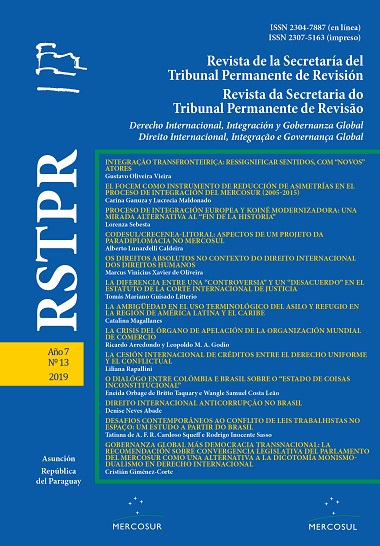Abstract
Currently human mobility is increasing, especially driven by reasons that push them to involuntarily migrate through the region, reasons such as the generalized and systematic violence of the Central American countries, the acute crisis of the countries of the region, currently Venezuela , Argentina, Nicaragua, among others, climate change, among other causes, added to this, international refugees from the war in Syria.
A human tragedy of unprecedented magnitude, which gives rise to the frequent use of legal institutes of international protection, asylum and refuge, used interchangeably and often imprecisely and even confused, especially in the Latin American and Caribbean region. In Latin America and the Caribbean, depending on the country or the regional regulation in question, both terms are used inaccurately or in synonyms in their domestic legislation, something that is erroneous and that is intended to be evidenced in this work or to conclude with proposals for terminological unification and differentiation of both legal protection figures.
Different legislations of Latin American countries and regional legislation are analyzed, as is the case of the Brazil Action Plan, highlighting its inaccuracy. The two advisory opinions of the Inter-American Court of Human Rights, OC-21/14, the Pacheco Tineo Family case against the Plurinational State of Bolivia of November 25, 2013, which deals with a pronounced inaccuracy in both institutes when trying to define asylum are also exposed. When in reality it is about refuge. And the last advisory opinion OC-28/18 at the request of the Republic of Ecuador where the Inter-American Court of Human Rights, tries to find a conceptualization and differentiation of both institutes through an integrating and enlightening classification of the functions of both institutes.
References
ACNUR. La situación de los refugiados en el mundo 1997-1998. Un programa humanitario. Barcelona: Icaria, 1997.
ACNUR. Manual de procedimientos y criterios para determinar la condición de refugiados en virtud de la Convención de 1951 y el Protocolo de 1967 sobre el Estatuto de los Refugiados.1988
ACNUR. Un instrumento de paz. Madrid: ACNUR, 1996.
ARGENTINA. Ley Nº 25.871 de Migraciones, artículo 3.d: garantizar el ejercicio del derecho a la reunificación familiar y su Decreto Nº 616/2010.
CORTE INTERAMERICANADE DERECHOS HUMANOS. Opinión Consultiva O-C 25 de 30 de mayo de 2018 sobre la institución del asilo y su reconocimiento como Derecho Humano en el sistema interamericano de protección.
ECUADOR. Ley Orgánica de Movilidad Humana, publicada el 6 de febrero de 2017.
Naciones Unidas. Convención Internacional sobre la Protección de los Derechos de todos los Trabajadores Migratorios y de sus Familiares. Adoptada por la Asamblea General en su resolución 45/158, de 18 de diciembre de 1990.
NACIONES UNIDAS. Decreto 2330 de 10 de septiembre de 1984 que faculta al CONARE como órgano responsable de los procesos de solicitudes de refugio.
OEA. Convención Americana de Derechos Humanos, 1978.
OEA. Convención de Asilo, de 20 de febrero de 1928, en la ciudad de la Habana, Cuba.
OEA. Convención sobre Asilo Diplomático de 1954, en Caracas, Venezuela.
OEA. Convención sobre Asilo y Refugio de 1933, en Montevideo, Uruguay.
OEA. Declaración Americana sobre Derechos Humanos.
OEA. Declaración de Brasilia Sobre la Protección de Personas Refugiadas y Apátridas en el Continente Americano de 2010.
OEA. Declaración de Cartagena sobre los Refugiados de 1984.
OEA. Declaración de San José sobre Refugiados y Personas Desplazadas de 1994.
OEA. Declaración y Plan de Acción Brasil 3 de diciembre 2014.Directiva 2004/38/CE del Parlamento Europeo y del Consejo, de 29 de abril de 2004.
PARAGUAY. Ley 1938 General sobre Refugiados.
PARAGUAY. Ley 798/96 de Migraciones.
República Dominicana. Ley Nº285-04 del 15 de agosto de 2004 y su reglamento 631-11 de 19 de octubre de 2011.
Unión Europea. Convención para la Protección de los Derechos Humanos y de las Libertades Fundamentales, 1950
UNIÓN EUROPEA. Directiva 2003/86/CE DEL CONSEJO de 22 de septiembre de 2003 sobre el derecho a la reagrupación familiar.
UNIÓN EUROPEA. Directiva 2005/36/CE del Parlamente Europeo del Consejo de 7 de septiembre de 2005 relativa al reconocimiento de cualificaciones profesionales.

This work is licensed under a Creative Commons Attribution 4.0 International License.
Copyright (c) 2019 Revista de la Secretaría del Tribunal Permanente de Revisión
